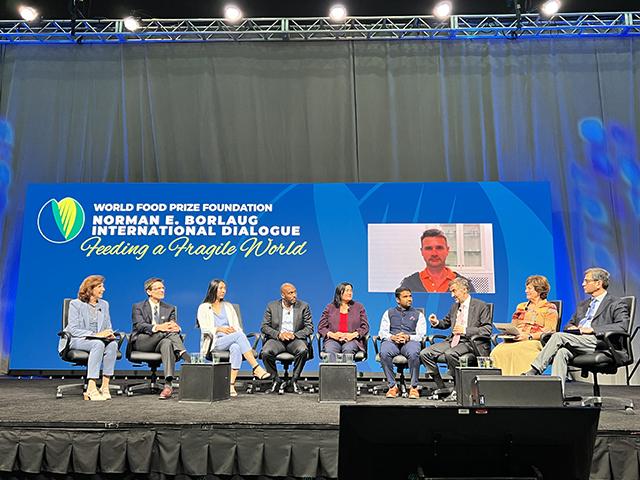Four Themes at World Food Prize Dialogue
Conflict, Productivity, Climate and Innovation Drive Global Food Security Focus
DES MOINES, Iowa (DTN) -- Conflict and climate were repeated themes in the opening sessions of the World Food Prize Foundation's Norman Borlaug International Dialogue on Tuesday.
The annual event typically highlights scientific and policy in dealing with both the challenges and success stories in global food production. The World Food Prize event this year is focused heavily on fragile food supply chains and the disruption caused by the war in Ukraine.
A few themes were repeated by keynote speakers and panelists when it comes to the rise in global hunger and risks to both food production and delivery.
1. CONFLICT
Conflict is both a cause and effect of food insecurity, said Cary Fowler, a special envoy for global food security at the State Department
"What happens in Ukraine doesn't stay in Ukraine," he said.
The war has shifted the focus of the State Department more on food production and aid challenges, as Fowler came on to the department in that role last spring.
The war plays into fertilizer production and access due heavily to Russian natural gas supplies. Natural gas makes up 85% of the cost of nitrogen fertilizer. With the gas supply to Europe being squeezed, roughly 75% of nitrogen production in Europe is idled right now because of limited access and high natural gas prices.
While the Black Sea deal struck in late summer has allowed Ukraine to export grain, that deal between Russia, Ukraine and United Nations could end.
"There's no real assurance that agreement, which lapses at the end of November, will continue," Fowler said.
Speaking through a livestream, Kees Huizinga, a farmer in Ukraine about 120 miles south of Kyiv, said he never expected to be in an unprovoked war. He's supposed to be harvesting corn right now, but harvest came to a halt after the Russians began launching more drone strikes in recent weeks.
P[L1] D[0x0] M[300x250] OOP[F] ADUNIT[] T[]
"We have to make sure Russia leaves Ukraine," Huizinga said. "We have to make sure Russia pays for the damages inflicted on Ukraine."
Huizinga said he would have to wait and see if the air raid alarms are going off Wednesday before deciding if he can get back to his corn crop.
2. PRODUCTIVITY
The Global Agricultural Productivity (GAP) report produced by Virginia Tech University shows agricultural production needs to increase an average of 1.73% per year to sustainably feed more than 9 billion people by 2050. The rate of productivity, however, has slowed. From 2011-2020, global agricultural productivity grew at an average of just 1.12% per year, a significant drop from the average growth rate of 1.99% from 2001-2010.
"The world is not on pace to meet growing food needs," said Steve Censky, CEO of the American Soybean Association and former USDA deputy secretary. "We need to increase productivity to get on pace."
Not everything in food production has to focus on yield and volume. There's a growing concern about the nutritional value of crops as well, said Aran Baral, CEO of HarvestPlus, a group focused on biofortified crops. "The focus on yield is so much that people have forgotten about nutrition," he said.
3. CLIMATE
Beyond conflict, Fowler said he sees a greater risk to global food production coming from climate change as temperatures rise. That tied into the need for more investment in helping crops adapt to climate change.
When it comes to corn, for instance, Fowler noted a 1 C (1.8 F) increase in temperatures will increase pest damage by as much as 20%.
Agriculture will need tools to intensify production on current land, or farmers globally will end up putting more marginal ground into production, he said.
Meanwhile, extreme weather continues to erode productivity and the ability to deliver what is produced.
Hurricane Ian has decimated the Florida citrus industry, which is now looking at the smallest orange crop since 1943.
The drought conditions in the northern part of the Mississippi River watershed and its main tributaries now also have limited barge traffic south of Memphis. That has impacted farmers along the river terminals across the Midwest with lower soybean and corn bids, as DTN reported this week.
See, "Sandbars and Saltwater Causing Serious Issues on Lower Mississippi River," https://www.dtnpf.com/….
4. INNOVATION
"What we really need is innovation that contributes to the robust food system, but is actually kinder to the planet," said Barbara Stinson, president of the World Food Prize Foundation. She added, "So if you think about innovation, what can you do that brings the value we need to the food system, to the farmer, but is actually more beneficial to the planet?"
That needed innovation requires greater investment in basic agricultural research. U.S. funding for agricultural research is lower than in the 1980s. That has a ripple effect and slows production innovation.
"Our public spending in real dollars has fallen by one-third in recent years," Censky said.
Censky added regulation must also embrace innovation, pointing to the productivity potential of gene-editing technology, for instance. Regulatory restrictions can stifle that technology and limit seed innovations.
Globally, Fowler said another challenge is there is an array of crops that do not have any research focus, which he called "orphan crops," where there is a great deal of potential for nutrition improvement or drought tolerance, but that requires long-term investment beyond the four or five major crops drawing most of the R&D focus.
"The humanitarian need is going to overwhelm us unless we put programs in place that are going to ramp up production," he said.
Chris Clayton can be reached at Chris.Clayton@dtn.com
Follow him on Twitter @ChrisClaytonDTN
(c) Copyright 2022 DTN, LLC. All rights reserved.




